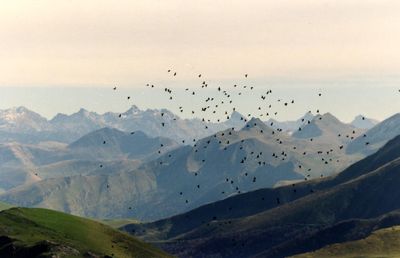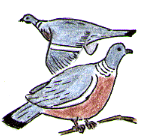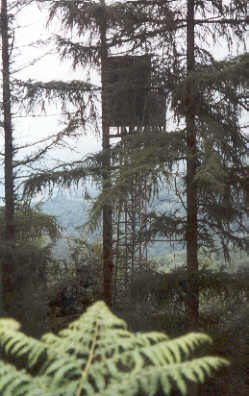|
Read about - The traditional Basque woodpigeon hunt...
From an article published in The Gourmetfly Newsletter of
September 1999 - some pictures are placed below.
Saint Luke in the Basque Land - October 18th is Saint
Luc, and the old saying goes: "à la Saint Luc... le grand
truc !" it is only a saying among palombe hunters in the
South-West of France. At Saint Luke, The big thing ! It is supposed to
be the migration peak of this more than appreciated pigeon. The bird
causing serious fever to the south-westerner hunters. Many of them take
a month holiday just to wait for the mythical flocks. There are many
ways to hunt them but what is done by the Basques on top of the
Pyrenees is unique in the world. Let me try to explain.
Those pigeons come from subarctic parts of our continent like Russia or
Scandinavia heading to the south of Spain and North-Africa. They move
in big flights making few stops and their migration lasts from early
October to mid November. On their way, they must cross the high
Pyrenees mountains. There, for over centuries, the Basques have
developed an amazing technique to catch them with nets. The clue was
found by a monk of Orreaga - Roncevaux Abbey 6 or 700 years ago. He
observed that falcons and hawks were also waiting for the birds. As the
mountain is quite high, the effort for the palombes to fly across is
very important. They are flying through passes using the same route
since ever. Here are waiting the hawks for a nice strategic attack and
the promise of good food. They attack under the flock. The monk noticed
that when the hawk attacks the flock, the pigeons are too tired to fly
away or gain more altitude as usual. So they dive to the ground and
escape from the bird of prey like this, continuing to fly at very
little distance of the ground.
The Basques imagined to imitate the hawk's attack to make them dive
into a net. You must figure out that all this happens on the top of a
big chain of mountains. Firstly, the birds arrive flying at an altitude
of 1000, 1500 meters, (4.00 ft) they fly along the mountains and some
Basque guys are here trying to keep the flock in the right lane with
big white flags, horns and their famous shouts. These are called xatarlari.
It means the guy who uses the whip-flag called xatar, pronounce
it like chat, in English. They really have a stunning voice. If
the flight leaves the lane leading to the pass, they begin to shout
like hell, use the flag and the horn, beat some sort of drums, and the
birds keep flying well centered.
Then they get close to the net, they are still very high in
the sky. So the Basques have built towers on top of the mountains. And
it is a high mountain. The towers are still very low compared to the
flock. Now comes the invention of the monk: The guy on the tower called
abatari, very strong and skilled man, starts throwing
sorts of wooden battledores painted white with chalk. This produces a
pretty good imitation of a hawk's attack and with luck the flight
should dive to the small net in the center of the pass. Maybe I'm not
explaining well, but believe me, this is something very impressive and
means a lot of skills and efforts to succeed.
So, on Saint Luke many people go there to watch or eat some salmis
or plantxa grilled palombes in the restaurants nearby. I was among
them. And I always appreciate it. The grilled palombes are fantastic
but it is a secret process that few people can reproduce out of the
Pays Basque. You must try this on the spot around Donapaleu, Osquich,
Saint Etienne de Baïgorry or Sare.
If you want to try a Salmis de Palombe at home - It
is a red wine stew and I guess the recipe applies to any wild pigeon in
the world. Only one thing is highly important, no fat bird should be
used as the grease would melt in the stew and result would be poor - I
have had a very bad culinary experience in Spain with turtle dove
overfed with sunflower seeds - Salmis can be prepared canned or
preserved. You can also cook and deep freeze in portions very quickly
ready when you want to use later. This is an enjoyable alternative home
"fast food".
Take a wild pigeon, roast it a short while in an oven. Take it out and
cut it into parts. Two breasts two legs, and the rest. Take the skin
and bones cut in pieces, put in a casserole with butter (locals would
use goose fat). Add a small carrot and an onion, also cut in small
pieces, garlic, parsley, thyme, bay leaf and let it take color. Add a
spoon of flour, mix well and let it take color again. Add two glasses
of strong red wine (Irouléguy) and a spoon of brandy, give some
heat, place the breasts and legs in the preparation then boil gently at
low heat for an hour. Take the breasts and legs out, then press and
strain the sauce. The sauce must be rather thick. Serve with mushrooms
and potatoes. Sprinkle with a little of fresh parsley.
Pictures below courtesy of Ian and Jess
MacLean
|



